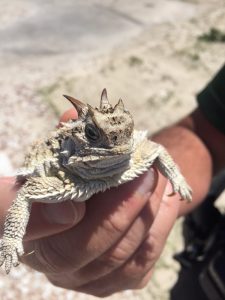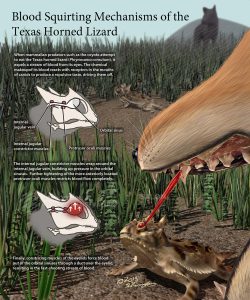
Well, the TCU Horned Frogs didn’t make much of a splash during the college football championship earlier this week. Despite the outcome of the game, their unusual mascot is one of the more intriguing among universities. After noticing the team helmets and spiky design around the jersey collar, I found myself digging into the animal’s natural history a little more.
First off, horned frogs or “horny toads” are a misnomer. The animal Phrynosoma cornutum is not an amphibian, but a wide-bodied lizard (the Texas State Lizard, in fact) that has several frog-like physical attributes. Native to arid, sandy climates like Mexico, Texas, and the American Midwest, the population has spread a bit, including—to my excitement—a reproducing population right here on our local barrier islands. They were most likely introduced to our region (and other southeastern states) as released pets that adapted quickly to local conditions. Thankfully their presence has not seemed to result in many negative impacts, as introduced species often do.

Based on discussions with colleagues and reports from longtime residents, horned lizards were common in the turkey oak and longleaf pine-dominated sandhills and sand dunes of Escambia, Santa Rosa, and Okaloosa County in the 1970’s and prior. A county co-worker and the Escambia County sheriff’s office have reported finding individual animals in Perdido Key in the the last few years. Most likely, those once easy-to-find lizards have dwindled due to development of roads, neighborhoods, and shopping centers throughout these upland areas.

Native populations of the reptile exist in Texas, Kansas, and a handful of other states. However, due to the common use of pesticides and loss of their primary food source (harvester ants) due to invasive fire ants, they are considered a federally threatened species. There are 15 species of horned lizards found in the United States, and they share several distinguishing characteristics. They tend to be 2-4” long, with females larger than males. The lizards are snub-nosed, with wide abdomens and a frog-like posture. Coloration ranges from shades of white, gray, brown, and red, with mottled camouflage patterns that help them hide in sandy ecosystems. They appear armored, with long bony horns on their heads and a frill of spiky scales around their necks and often down their abdomens.
 Perhaps the coolest and weirdest feature of Texas horned lizards is their arsenal of defense mechanisms. While their spikes would certainly deter many would-be predators, they also produce a toxin that tastes bad to dog species. This seems likely a result of co-evolution with desert coyotes, although their predators include snakes and large birds of prey. The toxins, present in the skin, are also circulated in their blood. When picked up or in peril, the lizards can literally squirt blood from their eye sockets to fend off predators. This technique quite obviously confuses and scares an animal threatening the lizard. This year’s TCU football uniforms even featured a nod to that bloody technique, with a red-tinged alternate “spit-blood” uniform worn during their game against Oklahoma State.
Perhaps the coolest and weirdest feature of Texas horned lizards is their arsenal of defense mechanisms. While their spikes would certainly deter many would-be predators, they also produce a toxin that tastes bad to dog species. This seems likely a result of co-evolution with desert coyotes, although their predators include snakes and large birds of prey. The toxins, present in the skin, are also circulated in their blood. When picked up or in peril, the lizards can literally squirt blood from their eye sockets to fend off predators. This technique quite obviously confuses and scares an animal threatening the lizard. This year’s TCU football uniforms even featured a nod to that bloody technique, with a red-tinged alternate “spit-blood” uniform worn during their game against Oklahoma State.
Whether you’re a fan of the football team or the lizards, it’s worth noting that an encounter with the “underfrogs” will leave a memorable impression.
 9
9
